Whether you go to a top restaurant or an ordinary restaurant to eat steak in United States. First of all, you need to know about steak USA. In addition to steak doneness, the names of the various steaks on the menu and their characteristics is also an important step. These two things directly determine the flavor of the steak itself. If you want different flavors, then you will need sauces and wines or drinks to go with them. Therefore, it is important to understand the characteristics of the steak. In order to order your meal more elegantly, deliciously and emotionally.
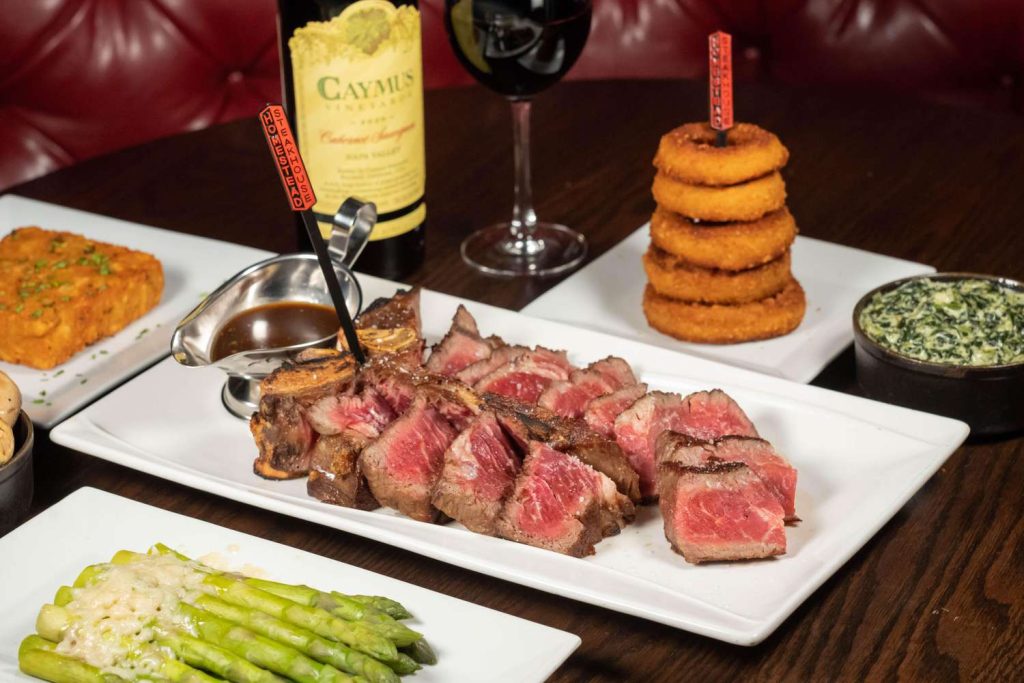
Best Steak House in America
Keens Steakhouse
Keens Steakhouse was founded in 1885. The location is in the Pioneer Square neighborhood of midtown Manhattan. It was converted from a 19th century pipe club. It is divided into four rooms: Bull Moose Room, Lambs Room, Lillie Langtry Room, and Lincoln Room. The portions of the restaurant’s meals are generous. The popular Prime Rib of Beef, King’s Cut is listed at $59. The Prime T-Bone Steak is listed at $56.
Keens uses USDA Prime grade steaks throughout the restaurant. That’s as good as any fine steakhouse. But Keens also does its own dry-aged treatment. Being one of the few restaurants in New York that still uses fruit wood to grill their steaks.
But it’s not the steaks that really put Keens at the top of the New York steakhouse pecking order, it’s the Legendary Mutton Chop, a dish that Keens insists on using because the fat distribution of the meat is better suited to the dish as it ages. This lamb chop is paired with a secret honey mint jelly. The light mint and sweet honey blend perfectly with the mildly stinky lamb, allowing this lamb chop to retain its rich flavor without being too mushy.
Gallaghers Steakhouse
Gallaghers Steakhouse, located in New York City’s Times Square and in the center of the Broadway Opera House.This steakhouse is a long-established local steakhouse that has been in business since 1927. It started out as a speakeasy in the Prohibition era, and with the lifting of Prohibition. It transformed itself into the first steakhouse in the center of Broadway, with locations in New York City, Atlantic City, and Las Vegas, Atlantic City, and Las Vegas.
Before entering the restaurant, you will shock by the steak air-drying and maturing room. From the whole glass outside the restaurant. You can see that this magnificent room is fill with top quality beef. It is getting mature for 21 days in a constant temperature and humidity environment. It sealing in the grease and moisture, resulting in tenderness and mellow flavor. Popular with American politicians, businessmen, sports and entertainment personalities. Gallaghers is one of the premier steakhouses in the New York City area, with USDA Prime Rib a popular staple. And of course, Japanese Wagyu beef and other outstanding seafood entrees. The legendary New York Strip New Yorker Steak got its name when it was first served at Gallaghers.
The Porterhouse Steak is the flagship of New York steakhouses. Not all steaks with bones can be called Porterhouse. Only those that meet the sufficient thickness + T-Bone can be called Porterhouse.
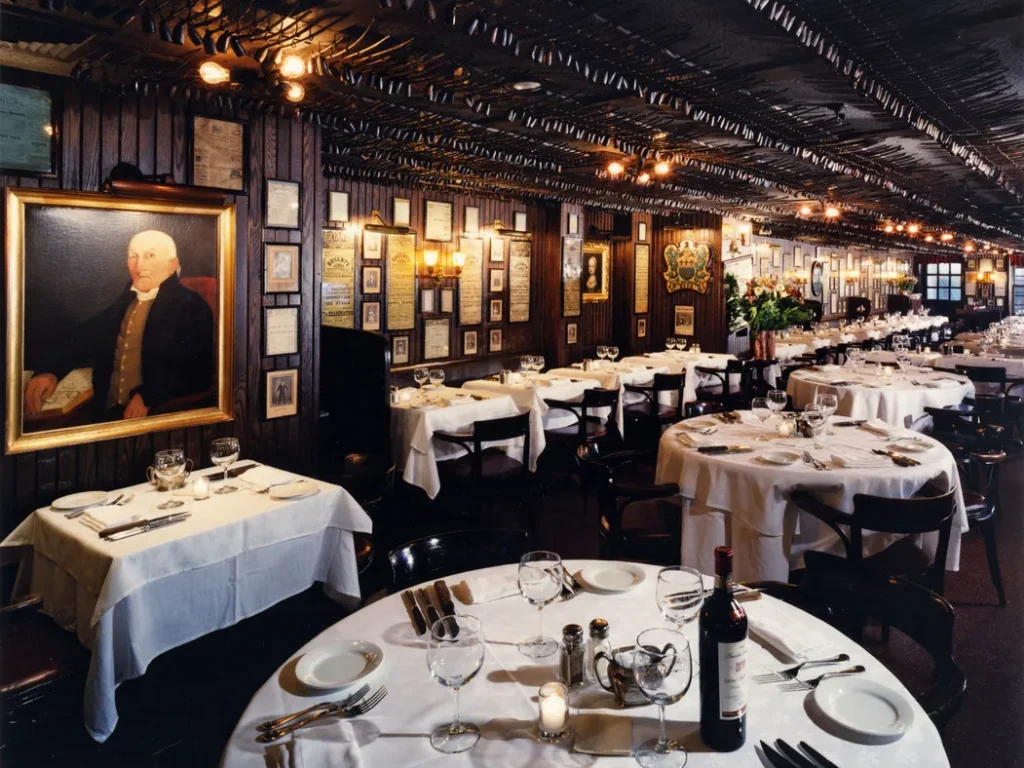
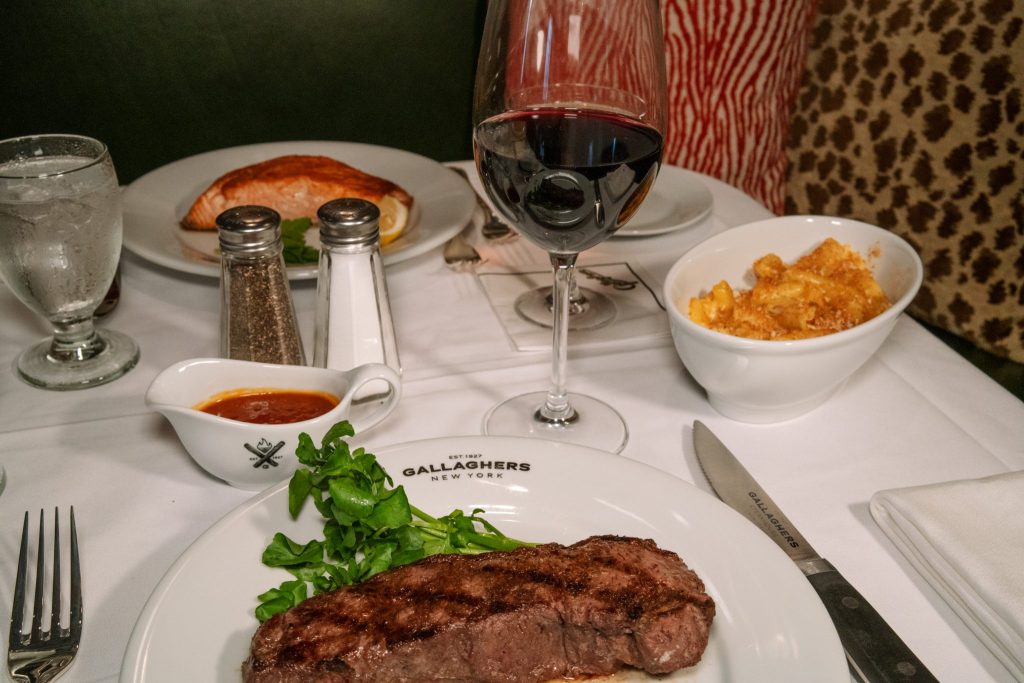
Peter Luger Steak House
Peter Luger Steakhouse has been honored with the title of “Best Steak in New York” for many years in a row. And has also been awarded one Michelin star many times. Peter Luger has two branches in New York, one in Brooklyn and one in Great Neck.
After being seated, guests are served with pre-dinner bread and Peter Luger’s homemade steak sauce with carrots/apples and anchovies.
The Porterhouse steak, is naturally at the center of the menu. But before the steak is officially enjoyed, the Sizzling Bacon is served as a true appetizer. The final step in the grilling of the steak is done directly on the plate on which it will be served. That’s why you see Peter Luger’s steak plates dirty. But the steak stays warm for most of the meal as a result. In several steakhouses, Peter Luger has mastered the caramelization layer. First you taste the crunch, then the tenderness. And finally the juices burst from the tender fibers as the aromas converge and explode in your mouth.
In addition to the signature steak. The chocolate sundae is the steakhouse’s famous dessert. It traditionally served with a dollop of “free” whipped cream and garnished with toasted walnuts.
Ruth's Chris Steak House
Ruth’s Chris is a specialty steakhouse with over 100 locations in the United States. It’s perfect for friends, business, family, and couples. With a legendary recipe, each steak is grilled to the specified perfect doneness. The steak is then served on an insulated porcelain plate heated to 500 degrees Fahrenheit. Seasoned only with pepper and salt, no sauce is needed to savor the flavor of a prime steak. Using only Prime Beef, which accounts for 2% of all beef produced in the United States, the steaks are cooked to the precise degree of doneness specified by the customer in a special oven.
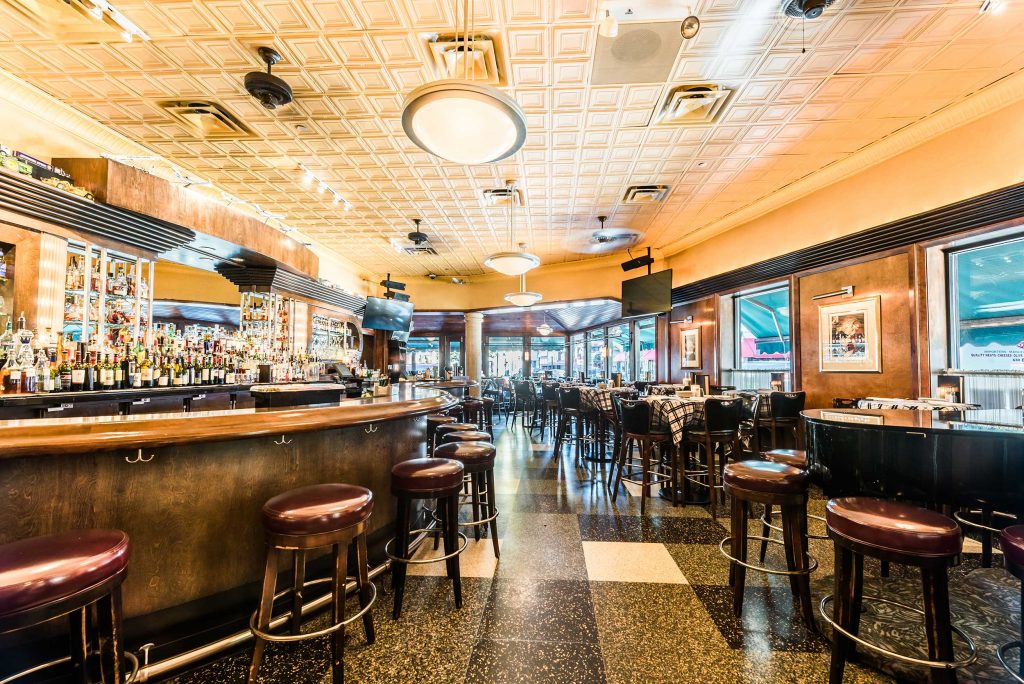
Gibsons Bar & Steakhouse
Giant steaks from a steady supply of Midwestern Black Angus cattle. Michelin and many nets are recommending it. The store is divided into two parts. One side of the Bar, the other side of the dining area. The store is also a lot of people, very Local steakhouse. Good service, all kinds of meat and seafood are brought up to the guests to choose. Also explaining the qualities of each meat. The most classic Chicago steak, the meat is slightly fat, suitable for people who like the fat meat. But the degree of charred internal tenderness grilled just! It is said that the Chicago steak are also hand-cut. To protect the natural texture of beef, eat more tender and delicious.
Steak Grades
Quality grading is based on the beef snow pattern standard. The cut between the sixth and seventh ribs of the cow. It is taken to see the distribution of the snow pattern. The more snow pattern the beef has, the better the quality. The highest grade of beef in Canada and the United States is Prime.
What is snowflake? The snow pattern of beef refers to the distribution of fat between the concealed meat. Fat brings out the flavor. And a steak with a good amount of snowflake is a great tasting steak. Prime grade steaks have the most snowflake and have the most tender flavor. The more snowflakes on the same part of the steak, the better. The more evenly distributed the snowflakes are, the better. The first thing that affects the snowflake pattern is the breed of cattle.
1. Wagyu
The term “Wagyu” is refer to beef produced in Japan. It was determined that only four breeds of beef. And namely the “Black Wagyu”, “Brown Wagyu”, “Japanese Shorthorn”, and “Hornless Wagyu”, could be called “Wagyu” in Japan. There are two parallel beef grading systems in Japan: breed grade (indicated by letters) and meat quality grade (indicated by numbers).
There are 15 grades ranging from A5 (the highest) to C1 (the lowest). With A5 being the highest grade of beef, known as “Frost Beef”, and C1 being regular beef. The flavor of top-grade Wagyu beef is unparalleled, with a soft texture, melt-in-your-mouth fat, and a distinctive milky flavor. The legendary “A5 Wagyu Beef” is the top choice – and, of course, the world’s best priced.
There are three grades: A, B, and C. A grade indicates that the beef comes from pure-blooded Kobe Wagyu, B grade from mixed-blooded Kobe Wagyu, and C grade from other countries, such as Angus Wagyu.
There is also an Australian Wagyu beef, which is a cross between Japanese Wagyu and Angus breeds. Compared to Japanese Wagyu, Australian Wagyu has less fat. There is more fibrous tissue and the beef flavor is more prominent. Beef in Australia is graded from M1-M12. Classified by meat color and fat distribution, M12 is the highest. The grade of Australian Wagyu Beef is usually between M4-M9, and M9 is equivalent to A3 grade Nissan Wagyu Beef.
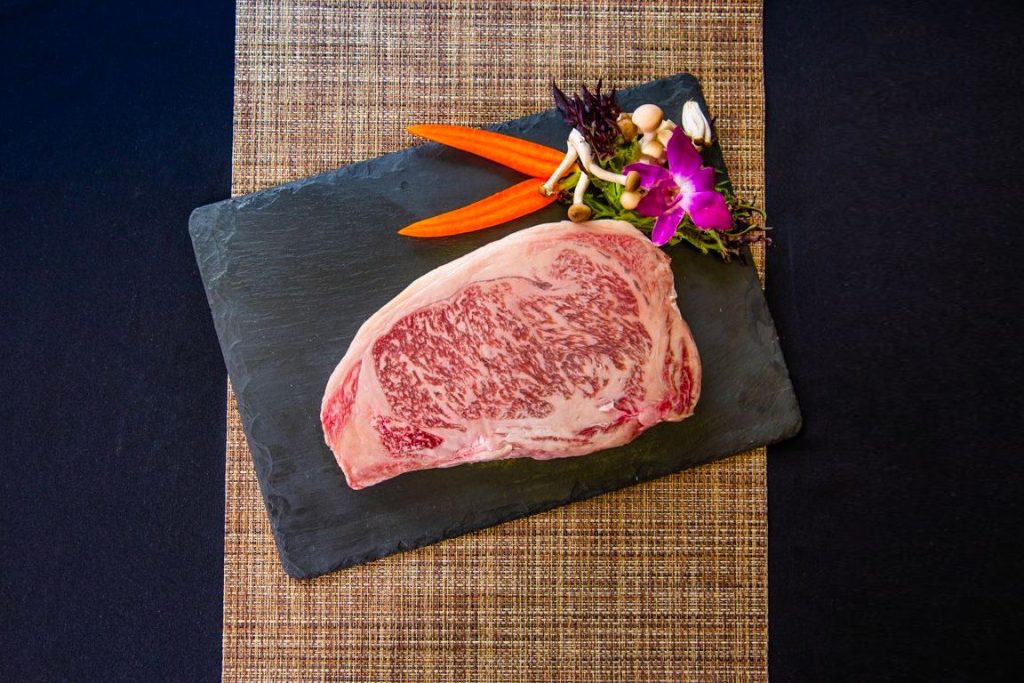
2. Angus
Premium steaks on the market labeled as originating in the United States. Most are of the Angus breed. Native to northern Scotland. The U.S. Angus beef is subject to the beef grading system developed by the U.S. Department of Agriculture (USDA): the quality level of U.S. beef is based on the quality of the beef (represented by marbling) and physiological maturity (age) is divided into: excellent (Prime), preferred (Choice), selectable (Select), qualified (Standard), commercial (Commercial), Utility, Cutter and Canner.
In general, steakhouses use Prime or Choice grade beef. The younger the cow and the more marbling (marbling) the beef has, the higher the grade.
Prime is the highest grade of steak in the U.S., producing only 2% of the market, it is scarce and expensive, and is almost exclusively supplied to hotels and upscale restaurants; Choice is the second grade, and is second only to Prime in terms of meat quality, texture, and cooked gravy and flavor, and possesses a price advantage.
Compared to Wagyu, Angus beef has a tighter texture, lower fat content, chewy toughness, and a stronger beef flavor.
Steak parts menu
1. Tenderloin Steak USA
Filet mignon is taken from the loin (tenderloin) of the cow. It is also known as the “tenderloin” or “loin”.
Only a few pounds of filet can be cut from every thousand pounds of cattle. And it is the most tender part of the beef. It is usually the most expensive steak.
This part of the beef has very little exercise. So the meat is buttery tender and low in fat. Making it a steak that can be savored with elegance.
Filet mignon is recommended to be eaten medium rare. As overcooking will toughen the meat and prevent you from tasting the juiciness and subtle, delicate flavor of filet mignon.
2. Rib-eye Steak
Ribeye steak is a muscle taken from the spine of a cow’s ribcage near the backbone. The steak usually comes with the signature small, curved section of the ribcage. Rib eye steaks are taken from the same area, but without the bone.
Rib eye steaks are second only to filet mignon in tenderness. The veins are well oiled and evenly distributed. Rib-eye steaks usually have a noticeable patch of grease in the center and are recommended to be cooked to 5 to 7 minutes of rare. Cook through the fat to give off a buttery flavor. Tender and chewy, it is the most popular and well known part of the steak. The most popular and well known part of the steak is the rib steak, which is also known as Cowboy Steak or Rib Steak as a rougher way to eat it without removing the ribs.
3. Sirloin steak USA
Sirloin steak in the United States refers to the meat on both sides of the spine of the cow’s hindquarters. Which is tender and expensive. Among them, the top sirloin has the best meat quality and the highest price, which is usually labeled.
Sirloin steak, the meat is moderately tender. Less greasy but evenly distributed. Beef flavor is good, this part is close to the leg muscles of the movement, so slightly chewy. Top sirloin is the best cut and the most expensive, and is usually labeled as a prime rump steak.
4. New York Steak
Taken from the front loin and spine part of the cow. As this part is a little more athletic, so the meat is firmer. The oil is evenly distributed, the fat content is between the rib eye and filet mignon. It has a rich beef flavor that is suitable for savoring boldly. And the chewing is meaty and very enjoyable, it is recommended that it is cooked in 3~5 minutes. Chewy and a favorite of Americans, hence the name New Yorker. In the United States, this part of the steak is commonly used in steakhouses and clubs, and is also called Club Steak.
5. Short Rib
Taken from the ribs of the front breast of the cow. It can be bone-in or boneless. This part of the meat is firm and has a lot of oil and fat. It is suitable to be grilled. During the grilling process, the oil will overflow with the high temperature, and the beef will have a good flavor. The recommended degree of doneness is 7 minutes to well done. When grilled until fully cooked, the beef will contract and separate from the ribs naturally, which is the best time to show the crispy tendons and chewy texture of beef chops.
6. T-bone
Taken from the front loin of the cow. Remove the center butternut bone from the steak. There is a piece of Filet Mignon and a piece of New Yorker Steak. The nature of these two parts is very different. The Filet Mignon is lean and tender. The New Yorker is chewy and oily. Tenderloin steaks fulfill both needs and are usually served in larger portions, with a recommended doneness of 3 to 5 minutes.
However, the size and proportions of the filet and New Yorker will vary depending on where the loin is sliced. If the sliced part is closer to the end, the diameter of the fillet is larger. Then such a tenderloin is called porterhouse.
The porterhouse steak is a deluxe version of the T-bone steak with a larger tenderloin and is more expensive. If the slices are close to the head, the filet portion will get smaller and smaller, or even a thin slice is left, which is the typical T-bone.
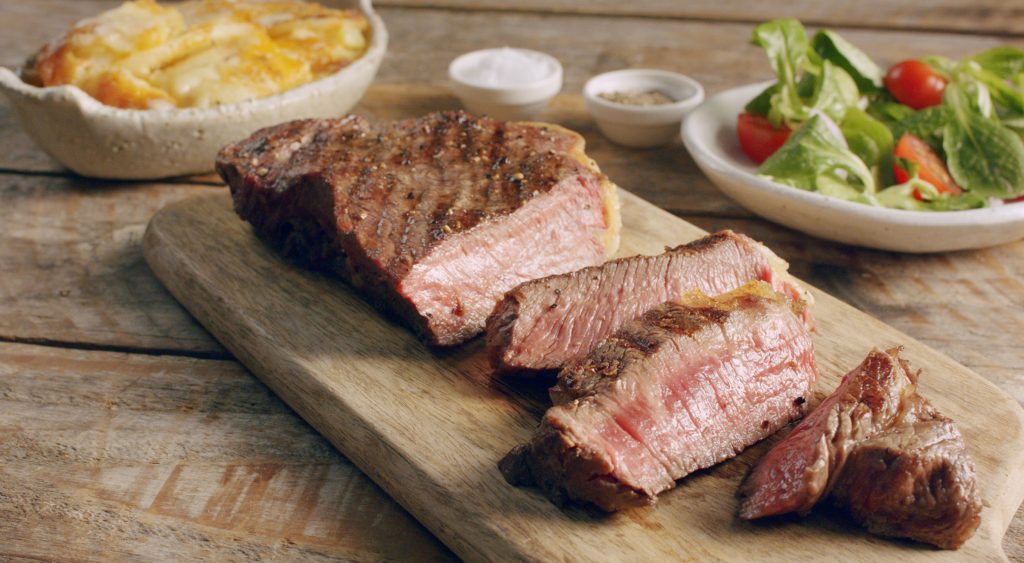
Steak USA Doneness
1-3
Blue Rare
The steak is seared on the front and back. But the inner layer is still blood-red. With a clear texture on the inside and outside, retaining the fresh and tender flavor of the original meat.
Rare
Only the surface of the steak is cooked to a grayish-brown color. With the center of the meat being a jewel-like blood red color that radiates outward from the inside to the well-done layer. Steaks at this degree of doneness are tender, with a juicy flavor and a confluence of rare and cooked layers. The core temperature is slightly higher than the body temperature, about 48.9 °C (120 °F).
Medium Rare
The degree of doneness chosen by most gourmets. As it is preferred by most Americans. Where the meat has a blood-red center that gradually transitions to brick red and pink, and then to a grayish brown on the outside. The flavor is crispy on the outside and soft and tender on the inside. It has a “smooth, silky texture”, with a core temperature of about 52.2 °C (126 °F).
5-10
Medium-rare
The center of the meat is pink. Which takes up about 25% of the area, and gradually transitions to a grayish-brown color on the periphery. The texture is not too tender. But has layers of texture that are thick and heavy, and it tastes like it’s already cooked. The core temperature is about 63 °C (145 °F).
Medium Well
Predominantly grayish-brown inside, with a small amount of pink, with a thick, chewy texture and toughness. The core temperature is about 68 °C (154 °F).
Well Done
The outside is caramelized and the inside is grayish-brown and cooked all the way through. A well-done steak is the most difficult steak to sear. As it requires the meat to be juicy and smooth. And the texture of the steak to be visible when squeezed. The core temperature is above 73 °C (163 °F), but above 90 °C (194 °F) it is considered overcooked.
Sauces for Steak USA
Many of the best steaks are advertised as needing only a little sea salt and black pepper to make them delicious. This is, of course, the easiest way to season a steak. But America’s leading chefs agree that “the sauce is also the essence. And the sauce is not a secret recipe”. Many restaurants have roughly the same sauce. But each chef may interpret it differently, resulting in a multitude of delicious steaks.
1. Sauce au poivre
The most popular steak sauce. An authentic black pepper sauce uses pure beef bone-in teriyaki sauce as its base. To which freshly ground pepper, brandy, and fresh rosemary are slowly simmered. A good sauce is layered. With a rich peppery flavor followed by the aroma of brandy felt when chewing the beef. And finally a mellow beef bone-in flavor.
2. Demi-glace
The basic sauce in the black pepper sauce, and almost the granddaddy of half the traditional sauces. Recipes are not difficult, but the test of effort, roasted beef bones plus veal stock and some accessories, but to do a good job of this sauce, you need to turn the beef bones every 20 minutes in the oven, continuous roasting for 5 hours, and then into the soup simmered over low heat for 72 hours, fully evaporated deep into the marrow of the aroma, and then all the collagen in the beef bones into the soup. With it, the various flavors of the sauce has a “foundation”.
3. Sauce bordelaise
A red wine sauce with a bright and vibrant color and a smooth yet sweet taste. It has to be a red wine from Bordeaux. And also the beef bone broth is used as the base. Red wine and spices are added and simmered, and finally boiled beef bone marrow is added to enhance the flavor. The most authentic way to eat authentic red wine sauce is with Beef Bazas from Bordeaux, France. This special sauce is also served with beef on the principle that it is not usually served with Wagyu beef, as its high fat will cause the flavor of the butter to clash with the red wine sauce when it is roasted, overpowering the flavor of the red wine sauce.

4. Sauce aux Champignons
Mushroom juice is a large category, using cream as a base and adding different mushrooms to reflect the unique flavor of each mushroom. Luxury versions include black truffle juice simmered with black truffles, morel mushroom juice simmered with morel mushrooms, and so on. The evaluated mushroom sauce also has a special sweet and smooth flavor of white portobello mushrooms. The greatest attraction of this sauce is that it preserves and highlights the fresh, original flavor of the mushrooms.
5. Sauce béarnaise
This is a derivative of French Hollandaise sauce. It has a mellow, custardy flavor and a very dense texture. That makes this sauce a great summer pairing with steak. Pommes d’Or is made in a water bath of warm water at 56-62 degree. And the sauce is only about 30 degrees when served. Because of its long history, foreign food critics are generally extremely critical of the bourguignon sauce that appears in restaurants.
6. Sauce au fromage bleu
This heavy sauce is all about fermented cheese as a base. It’s hard for a lot of people to accept, though. But it is definitely one of the most French-inspired flavors. It has a history and flavors from various places that are almost comparable to red wine. Some say it combines both angelic looks and devilish tastes, with a pungent odor and a rich texture.
Steak USA with Drinks Recommendation
- Wines
- Whiskey (loanword)
- Stout
- Cranberry juice or red pomegranate juice
- Lemon Soda or Lime Soda

Steak USA with Staple Food Recommendation
1.Pasta
A steak must be accompanied by a plate of delicious pasta. There are so many types of pasta. There is macaroni, there is straight pasta, there is butterfly pasta and so on. With these various kinds of pasta. There are also more fancy Italian sauces. Tomato pasta is tart and very appetizing. And black pepper pasta is usually served with black pepper beef tenderloin for those who like pepper flavor. In general, pasta with steak is very suitable.
2.Pizza
Pizza is also a staple food from Italy. It is essential in Western cuisine. It is also very suitable with steak. Pizza crust is baked like bread, but it is very flat, put some vegetables and knowledge on it, and it becomes a classic pizza.
3. Fried Potatoes
In the United States, a staple that must accompany steak is fried potatoes. Fried potatoes here are not french fries. The shape of fried potatoes is wider than french fries, and they taste fuller and have a sweeter flavor.
Find a house in USA
If you are looking for a house rent in USA, uhomes is a good choice for you to choose apartment to live in New York, Los Angeles, Chicago, San Fransisco. There are different types of house for you to rent, and you can fill in a form. There will our consultant contact with you soon.
FAQ
New York City is home to Peter Luger Steakhouse, which has frequently been ranked as one of the best steakhouses in America. Chicago, known for its own style of steak, also boasts several top-notch steakhouses.
The Porterhouse steak is one of the most favored cuts in America, pulling in a significant 27% of votes. Known for its generous size and combination of tenderloin and strip steak, the Porterhouse offers a dual steak experience that’s hard to beat.
Steak lovers in the USA are truly spoilt for choice. With a myriad of cuts and styles available across the country. “The Duke” from RPM Steak holds the fifth position, offering an unforgettable steak experience. The fourth spot goes to the Prime Rib Roast from the House of Prime Rib. A testament to the timeless appeal of a well-cooked rib roast. Sitting at number three is the New York Strip Steak from Pappas Bros. Steakhouse, an embodiment of the classic flavor and texture that steak enthusiasts love. Finally, the 20-ounce Bone-in Ribeye from Bern’s Steak House takes the second spot. Showcasing the rich, full-bodied flavor that has made ribeyes a favorite among many.
The New York Strip Steak. It cut from the beef short loin. Right behind the rib area, is indeed a favorite among steak enthusiasts for its robust. Beefy flavor and harmonious blend of juiciness and meatiness. It might not be the most tender steak cut. But its intense flavor, with bold, beefy notes, more than makes up for it.
A Deep Dive into the Metropolitan Museum of Art Hidden
Metropolitan Museum of Art, is the largest art museum in the United…
Savoring Sweetness: An Exploration of Milk Tea in USA
For those of you who are studying or working in USA, milk…
JFK Airport Duty Free Shop Handbook for the Travelers
During the waiting time for a flight, people choose to browse the…











